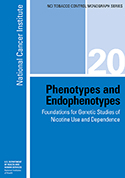
Reviews literature on genetic studies of nicotine use and dependence and presents a scientific plan for incorporating genetic research into cross-disciplinary studies of nicotine dependence. Chapters highlight theoretical considerations (including linking heritable genetic traits with nicotine dependence), modeling developmental trajectories to dependence, candidate endophenotypes, epidemiological and methodological considerations, and future directions.
On This Page
Supplementary Materials
- Overview Fact Sheet (PDF, 790 KB)
- Conclusions Fact Sheet (PDF, 768 KB)
- Research Fact Sheet (PDF, 787 KB)
- Overview Presentation (PPT, 369 KB)
The tobacco monographs can be ordered by sending an email to nci@gpo.gov. Please include the title and/or NCI Publication Number and the requested quantity.*
* Both Executive Summary (Publication ID: T141) and full reports (Publication ID: T140) available.
Suggested Citation
National Cancer Institute. Phenotypes and Endophenotypes: Foundations for Genetic Studies of Nicotine Use and Dependence. Tobacco Control Monograph No. 20. Bethesda, MD: U.S. Department of Health and Human Services, National Institutes of Health, National Cancer Institute. NIH Publication No. 09-6366, August 2009.
View Individual Chapters
Chapters and key topics covered within each chapter are listed below. Chapters generally include an introductory section, details on methodology, a chapter summary, research needs, and a reference list.
- Figures and Tables (PDF, 51 KB)
- Foreword (PDF, 22 KB)
- Message from the Series Editor (PDF, 29 KB)
- Acknowledgments (PDF, 48 KB)
- Acronyms and Abbreviations (PDF, 37 KB)
Part 1. Introduction (PDF, 43 KB)
- Chapter 1. Overview and Conclusions (PDF, 110 KB)
- About the Monograph
- Major Accomplishments
- Major Conclusions
- Chapter Summaries and Conclusions
- Chapter 2. Status of Genetic Studies of Nicotine Dependence (PDF, 363 KB)
- Historical Perspective of Genetic Research on Nicotine Dependence
- Nicotine Dependence: A Construct in Need of Refinement
- Nicotine-Dependence Phenotypes: A Framework
- Gentic Epidemiological Concepts and Their Implications for Studying Nicotine Dependence
- Summary of Selected Biometric and Measured Genetic Studies of Nicotine Dependence
- Issues in Communication of Genetic Findings
Part 2. Theoretical Considerations (PDF, 43 KB)
- Chapter 3. The Nicotine-Dependence Phenotype: Translating Theoretical Perspectives and Extant Data into Recommendations for Genetic Mapping (PDF, 448 KB)
- Construct Validation
- Distal Measures of Dependence
- New Directions for Phenotypic Research: Beyond Distal Measures
- Chapter 4. Mouse Models and the Genetics of Nicotine Dependence (PDF, 1.6 MB)
- Nicotinic Receptor Functional Diversity
- Routes of Nicotine Administration: Interaction of the Drug with Physiological Systems
- The Mouse Model of Nicotine Dependence
- Nicotine and Behavioral Changes
- Nicotine and Reward
- Tolerance
- Additional Directions for Research on the Nicotine-Dependence Phenotype in Mice
Part 3. Developmental Trajectories of Tobacco Use and Their Relation to Tobacco Dependence (PDF, 44 KB)
- Chapter 5. Developmental Trajectories of Cigarette Smoking from Adolescence to Adulthood (PDF, 285 KB)
- A Developmental Psychopathology Perspective: Studying Multiple Trajectories over Time
- Empirically Identified Trajectories of Adolescent Smoking
- Statistical Models for Evaluating Alternative Developmental Phenotypes of Smoking Behavior
- An Empirical Example: Trajectories in the Indiana University Smoking Survey
- Future Research Directions
- Chapter 6. Genetic Modeling of Tobacco Use Behavior and Trajectories (PDF, 484 KB)
- Methodological and Conceptual Issues
- Statistical Framework
- Review of Genetic Studies of Smoking
- Item Response Theory Approach: Application to Virginia Twin Registry Data
- Limitations
- Chapter 7. Trajectories of Tobacco Use from Adolescence to Adulthood: Are the Most Informative Phenotypes Tobacco Specific? (PDF, 287 KB)
- Importance of Studying Substance-Use Comorbidity
- Common Versus Specific Liability to Substance-Use Disorders
- Review of Trajectory Literature
- Associations between Substance-Use Trajectories and Other Substance Involvement
- Modeling Conjoint Trajectories of Substance Use
- Empirical Example of Modeling Co-Occurring Courses of Substance Use
- Results
Part 4. Endophenotypes (PDF, 42 KB)
- Chapter 8. Endophenotypes for Nicotine-Dependence Risk at or before Initial Nicotine Exposure (PDF, 352 KB)
- Endophenotypes
- Smoking Initiation and Progression Risk: Examination of Key Candidate Psychological Domains
- Initial Nicotine Exposure Response: Conceptual Framework and Candidate Endophenotypes
- Discussion of Future Directions
- Chapter 9. Nicotine-Dependence Endophenotypes in Chronic Smokers (PDF, 389 KB)
- Rationale for Investigating Endophenotypes of Chronic Nicotine Exposure
- Motivational Mechanisms
- Acute Smoking or Abstinence Effects on Cognitive, Affective, and Physiological Function
- Discussion and Recommendations for Future Research
Part 5. Epidemiological and Methodological Considerations (PDF, 46 KB)
- Chapter 10. Epidemiological Analysis of Variation in Phenotypic Definitions: A Proof of Concept Using an Example of a Cessation Phenotype (PDF, 214 KB)
- The Proposed Approach
- Method
- Chapter 11. Incorporating Social Context into Genetic Studies of Nicotine Dependence (PDF, 214 KB)
- Why Incorporate the Social Context?
- Behavioral Genetic Studies of Smoking That Incorporate Social Context
- Proximal Measures of the Social Context
- Future Directions
- Chapter 12. Using Ontologies in Hierarchical Modeling of Genes and Exposure in Biological Pathways (PDF, 2 MB)
- Methodological Issues
- Background on Statistical Approaches
- Methods
- Example: Nicotine Metabolism
- Discussion
- Appendix 12 A. Estimation for the Hierarchical Model
- Appendix 12 B. Model Selection Algorithm
Part 6. Future Directions (PDF, 49 KB)
- Chapter 13. Future Directions (PDF, 122 KB)
- Genetics and Nicotine Dependence: Implications for Basic and Clinical Research
- Future Directions
- Index (PDF, 116 KB)

